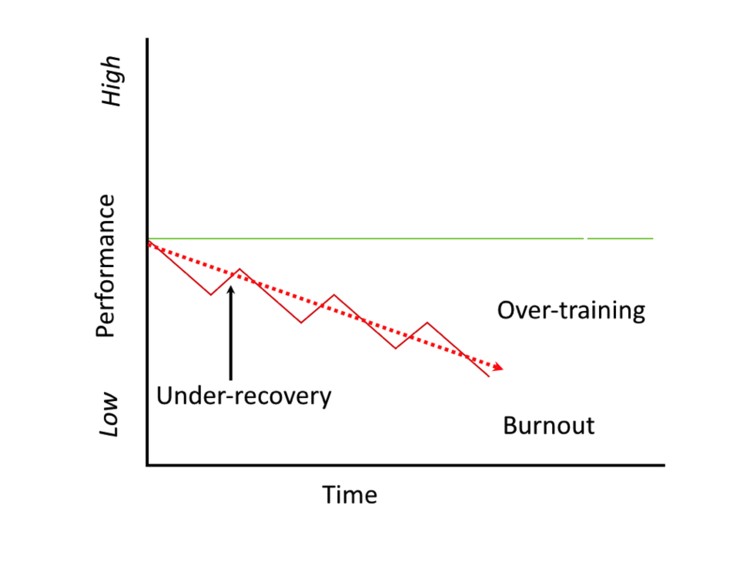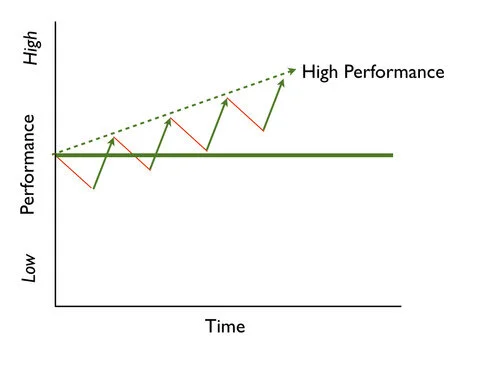How do I know if I'm recovering Optimally?
Click here to receive insights in our weekly newsletter.
Last week we discussed Decision Fatigue, and how COVID has led to “burnout”, similar to what athletes experience if they don’t give themselves enough time to rest.
On the other hand, when athletes get adequate rest and recovery, they are able to repair their tissues, rebuild their muscles, and replenish their energy stores. This is when the real adaptation occurs and they come back stronger than they were before. This is called Performance Cycling.
The same idea can be applied to all of us. If we’re exposed to high levels of stress repeatedly without sufficient time to recover, we become exhausted, burned out, stressed, and unable to make good decisions surrounding our health and wellbeing. But if we allow ourselves to have proper rest (both physically and mentally), we are able to amplify our performance - at work and at home.
The question then is how do you know if you’re recovering properly? How do you know when you’re pushing it too far? What’s considered a “normal” amount of fatigue?
It all comes back to the nervous system. The nervous system detects stress in the body and then sends these signals to the brain. The brain then activates either the parasympathetic nervous system via the vagus nerve, or the sympathetic nervous system via the sympathetic ganglia. If the body is recovering nicely and is in a rested/adaptation condition, then the parasympathetic system dominates and heart rate is decreased. On the other hand, if signals are being sent back to the brain indicating that the body is under-recovered, stressed, or trying to fight an infection, then the sympathetic system will dominate and heart rate will increase.
The other thing that happens when you’re stressed is that heart rate variability (HRV) decreases. HRV is a measure of the fluctuations in time between heart beats. A higher variation in beat-to-beat time is indicative of low stress, whereas a low variation is indicative of high stress. For more information on this, check out our blog on HRV.
Athletes take advantage of this connectivity to monitor their training and recovery status. We can do the same to measure our nervous system status and, hence, recovery and regeneration status. Here are two ways to do this:
Resting Heart Rate (RHR). The easiest way to track your recovery status is to measure your resting heart rate. Simply measure your pulse for 60 seconds first thing in the morning. Make sure you do this as soon as you wake up and while still lying in bed - even sitting up will increase your heart rate! If you take this measurement every morning, you should notice a relatively constant resting heart rate. If you are stressed, physically tired, or not recovered properly, your resting heart rate will likely rise - an indication that your sympathetic nervous system is overly active.
Heart Rate Variability (HRV). If you have an app or wearable device (such as our new VIIVIO app or similar device) that can track HRV, you can use this to track your recovery status. Just like heart rate, HRV will vary day-to-day depending on your training status, psychological stress, if you’re fighting off an illness, and other lifestyle factors. So it’s best to track your trends over a longer period of time. Also, while a high HRV is associated with good health, HRV is very individual. It’s much more useful to pay attention to how your HRV changes from day to day, as opposed to comparing yourself to other people. Finally, as it fluctuates throughout the day, you should measure it a few times per day, including once as soon as you wake up.
Once you have collected some data continually over a few weeks, you will notice that both your RHR and HRV change slightly from day to day. For example, if you had a hard workout the day before, your RHR might be higher and your HRV might be lower. This is expected. However, if you find that you’re consistently getting a high RHR and low HRV, this is an indication that you might not be recovering properly. If you find you’re going through a period of high stress (physically and/or mentally), here are a few steps you can take:
1. Prioritize sleep. Sleep is so important for both mental and physical recovery. Sometimes a good night's sleep is enough to give your body a reset and improve your recovery status. This is also why it’s important to measure your RHR and HRV first thing in the morning, as you should be the most recovered at that point in the day.
2. Allow yourself a day off from intense activity. This doesn’t mean don’t be active at all. It just might not be the day to do an intense interval session.
3. Breathe. Deep breathing is such a powerful way to decrease stress. This is because this type of breathing actually stimulates the parasympathetic nervous system. Even a few deep breaths throughout the day can help. To do this, inhale for 3 seconds, hold your breath for 1 second, and exhale for 3 seconds. Repeat this a few times. This deep breathing can also be incorporated into a meditation or yoga practice.
4. Take some time to unplug. In today’s world of the internet, and smartphones and watches, we’re constantly being bombarded with phone calls, messages, and news. It’s important to step away from technology and be fully unplugged once in a while. If you’re going through a period of high stress, leave your phone at home and go for a walk or hike and just enjoy being disconnected. This small dose of device-free time will leave you feeling refreshed, and will ease some of your psychological stress.
What are we finding in the research?
In 2019, a research team studied the relationship between RHR, HRV, and sleep in NCAA Division 1 female cross country athletes. The researchers observed that later in the season, when training load was high, the athletes had a higher RHR and lower HRV, and this was correlated with the percentage of time spent in slow wave sleep (or deep sleep). The researchers suggest that during periods of intense physical stress, athletes need more deep sleep to help repair their bodies from the physical demands of their sport. They suggest that using measures such as RHR and HRV, is an easy way for athletes to track their recovery and know when it’s time to prioritize sleep even more.
You can read the summary of the research paper here!



